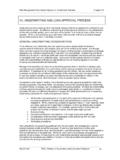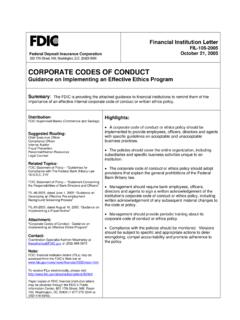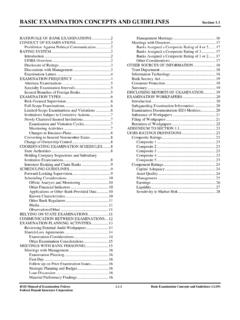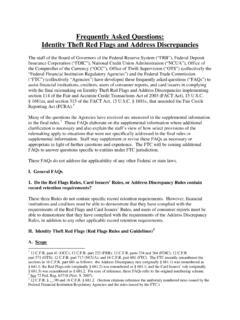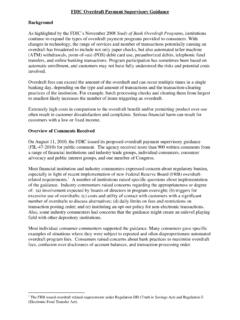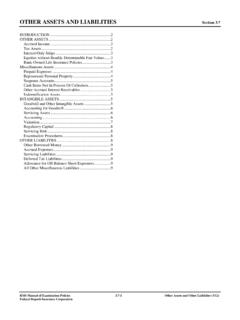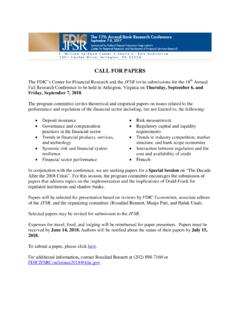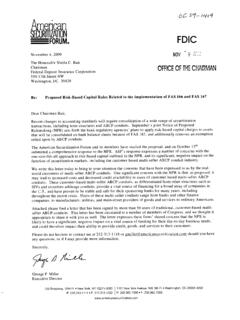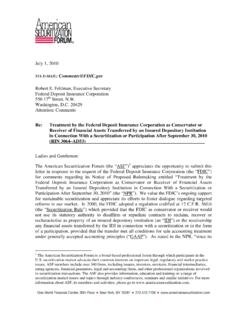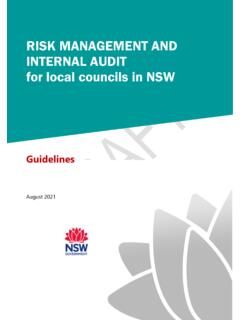Transcription of SUPERVISORY GUIDANCE ON MODEL RISK …
1 1 Federal Deposit Insurance Corporation SUPERVISORY GUIDANCE ON MODEL RISK management CONTENTS I. II. Purpose and III. Overview of MODEL Risk IV. MODEL Development, Implementation, and V. MODEL VI. Governance, Policies, and VII. I. INTRODUCTION Banks rely heavily on quantitative analysis and models in most aspects of financial decision They routinely use models for a broad range of activities, including underwriting credits; valuing exposures, instruments, and positions; measuring risk; managing and safeguarding client assets; determining capital and reserve adequacy; and many other activities. In recent years, banks have applied models to more complex products and with more ambitious scope, such as enterprise-wide risk measurement, while the markets in which they are used have also broadened and changed. Changes in regulation have spurred some of the recent developments, particularly the regulatory capital rules for market, credit, and operational risk based on the framework developed by the Basel Committee on Banking Supervision.
2 Even apart from these regulatory considerations, however, banks have been increasing the use of data-driven, quantitative decision-making tools for a number of years. The expanding use of models in all aspects of banking reflects the extent to which models can improve business decisions, but models also come with costs. There is the direct cost of devoting resources to develop and implement models properly. There are also the potential indirect costs of relying on models, such as the possible adverse consequences (including financial loss) of decisions based on models that are incorrect or misused. Those consequences should be addressed by active management of MODEL risk. This GUIDANCE describes the key aspects of effective MODEL risk management . Section II explains the purpose and scope of the GUIDANCE , and Section III gives an overview of MODEL risk management . 1 Unless otherwise indicated, banks refers to state non-member banks, state savings associations, and all other institutions for which the Federal Deposit Insurance Corporation is the primary supervisor.
3 It is not expected that this GUIDANCE will pertain to FDIC-supervised institutions with under $1 billion in total assets unless the institution s MODEL use is significant, complex, or poses elevated risk to the institution. 2 Section IV discusses robust MODEL development, implementation, and use. Section V describes the components of an effective validation framework. Section VI explains the salient features of sound governance, policies, and controls over MODEL development, implementation, use, and validation. Section VII concludes. II. PURPOSE AND SCOPE The purpose of this document is to provide comprehensive GUIDANCE for banks on effective MODEL risk management . Rigorous MODEL validation plays a critical role in MODEL risk management ; however, sound development, implementation, and use of models are also vital elements. Furthermore, MODEL risk management encompasses governance and control mechanisms such as board and senior management oversight, policies and procedures, controls and compliance, and an appropriate incentive and organizational structure.
4 Previous GUIDANCE and other publications issued by the FDIC on the use of models address aspects of MODEL risk management for specific types of models or pay particular attention to MODEL Based on SUPERVISORY and industry experience over the past several years, this document expands on existing GUIDANCE most importantly by broadening the scope to include all aspects of MODEL risk management . Many banks may already have in place a large portion of these practices, but banks should ensure that internal policies and procedures are consistent with the risk management principles and SUPERVISORY expectations contained in this GUIDANCE . Details may vary from bank to bank, as practical application of this GUIDANCE should be customized to be commensurate with a bank s risk exposures, its business activities, and the complexity and extent of its MODEL use. For example, steps taken to apply this GUIDANCE at banks using relatively few models of only moderate complexity might be significantly less involved than those at a bank where use of models is more extensive or complex.
5 III. OVERVIEW OF MODEL RISK management For the purposes of this document, the term MODEL refers to a quantitative method, system, or approach that applies statistical, economic, financial, or mathematical theories, techniques, and assumptions to process input data into quantitative estimates. A MODEL consists of three components: an information input component, which delivers assumptions and data to the MODEL ; a processing component, which transforms inputs into estimates; and a reporting component, which translates the estimates into useful business information. Models meeting this definition might be used for analyzing business strategies, informing business decisions, identifying and measuring risks , valuing exposures, instruments or positions, conducting stress testing, assessing adequacy of capital, managing client assets, measuring compliance with internal limits, maintaining the formal control apparatus of the bank, or meeting financial or regulatory reporting requirements and issuing public 2 For instance, the FDIC has addressed aspects of MODEL risk management in GUIDANCE related to different activities.
6 See Joint Agency Policy Statement on Interest Rate Risk (FIL-52-96), FFIEC Advisory on Interest Rate Risk management (FIL-2-2010), Interagency Advisory on Interest Rate Risk management Frequently Asked Questions (FIL-2-2012), FDIC s Credit Card Activities Manual ( ), and SUPERVISORY GUIDANCE on Implementing Dodd-Frank Act Company-Run Stress Tests for Banking Organizations With Total Consolidated Assets of More Than $10 Billion but Less Than $50 Billion (79 FR 14153). In addition, the advanced-approaches risk-based capital rules (12 CFR 325, Appendix D) contain explicit validation requirements for subject banking organizations. 3 disclosures. The definition of MODEL also covers quantitative approaches whose inputs are partially or wholly qualitative or based on expert judgment, provided that the output is quantitative in Models are simplified representations of real-world relationships among observed characteristics, values, and events.
7 Simplification is inevitable, due to the inherent complexity of those relationships, but also intentional, to focus attention on particular aspects considered to be most important for a given MODEL application. MODEL quality can be measured in many ways: precision, accuracy, discriminatory power, robustness, stability, and reliability, to name a few. Models are never perfect, and the appropriate metrics of quality, and the effort that should be put into improving quality, depend on the situation. For example, precision and accuracy are relevant for models that forecast future values, while discriminatory power applies to models that rank order risks . In all situations, it is important to understand a MODEL 's capabilities and limitations given its simplifications and assumptions. The use of models invariably presents MODEL risk, which is the potential for adverse consequences from decisions based on incorrect or misused MODEL outputs and reports.
8 MODEL risk can lead to financial loss, poor business and strategic decision making, or damage to a bank s reputation. MODEL risk occurs primarily for two reasons: The MODEL may have fundamental errors and may produce inaccurate outputs when viewed against the design objective and intended business uses. The mathematical calculation and quantification exercise underlying any MODEL generally involves application of theory, choice of sample design and numerical routines, selection of inputs and estimation, and implementation in information systems. Errors can occur at any point from design through implementation. In addition, shortcuts, simplifications, or approximations used to manage complicated problems could compromise the integrity and reliability of outputs from those calculations. Finally, the quality of MODEL outputs depends on the quality of input data and assumptions, and errors in inputs or incorrect assumptions will lead to inaccurate outputs.
9 The MODEL may be used incorrectly or inappropriately. Even a fundamentally sound MODEL producing accurate outputs consistent with the design objective of the MODEL may exhibit high MODEL risk if it is misapplied or misused. Models by their nature are simplifications of reality, and real-world events may prove those simplifications inappropriate. This is even more of a concern if a MODEL is used outside the environment for which it was designed. Banks may do this intentionally as they apply existing models to new products or markets, or inadvertently as market conditions or customer behavior changes. Decision makers need to understand the limitations of a MODEL to avoid using it in ways that are not consistent with the original intent. Limitations come in part from weaknesses in the MODEL due to its various shortcomings, approximations, and uncertainties. Limitations are also a consequence of assumptions underlying a MODEL that may restrict the scope to a limited set of specific circumstances and situations.
10 MODEL risk should be managed like other types of risk. Banks should identify the sources of risk and assess the magnitude. MODEL risk increases with greater MODEL complexity, higher uncertainty about inputs and assumptions, broader use, and larger potential impact. Banks should consider risk from individual models and in the aggregate. Aggregate MODEL risk is affected by interaction and dependencies among models; reliance on common assumptions, data, or methodologies; and any 3 While outside the scope of this GUIDANCE , more qualitative approaches used by banking organizations , those not defined as models according to this GUIDANCE should also be subject to a rigorous control process. 4 other factors that could adversely affect several models and their outputs at the same time. With an understanding of the source and magnitude of MODEL risk in place, the next step is to manage it properly.
